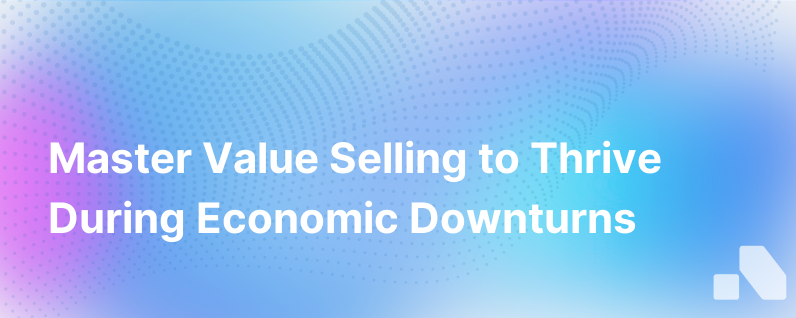
In the face of economic uncertainty, it is imperative for companies to reassess their sales strategies to ensure they remain competitive and successful. Value selling emerges as the beacon during such challenging periods, and understanding its significance can be pivotal for businesses aiming to not only survive but thrive during a downturn.
Value selling is a sales technique that focuses on the customer’s understanding of the value they will derive from a product or service. The economic value is communicated in terms that are relevant to the customer, such as increasing revenue, reducing costs, improving efficiency, or mitigating risk. Here's why embedding value selling into your sales strategy can be your best move in times of economic downturn.
Building Trust, Not Just Transactions
During a downturn, businesses scrutinize every decision more closely, particularly around expenditures. Sales that focus solely on features and benefits without clear alignment to business outcomes will miss the mark. Value selling shifts from a transactional approach to one that forges trust. It shows potential clients that you understand their challenges and are invested in their success.
Trust becomes a critical currency when budgets tighten. Customers want to feel assured that they are making the right investment, and a sales team that articulates value effectively will rise above competitors who are simply selling a product or service.
Shifting from Cost to Investment
In a downturn, the concept of "cost" can overshadow potential investments. Value selling reframes the conversation to focus on the long-term return on investment (ROI) your solution provides. When customers are presented with clear and credible data that demonstrates how your offering will help them save or make more money in the long run, the conversation moves away from expense and towards strategic investment, which is easier to justify.
Longer Customer Lifecycle and Loyalty
When customers understand the value they derive from your solutions, they are more likely to view them as essential. This understanding fosters loyalty, contributing to a more stable customer base. During an economic downturn, this loyalty can be a lifesaver for businesses as it provides a level of predictable recurring revenue that can help weather the storm.
In value selling, you also continually assess and affirm the value you bring to customers, which can lead to prolonged engagement and the identification of new opportunities within existing accounts. This not only smooths out rough economic patches but also deepens the relationship, leading to valuable referrals and testimonials.
Standing Out in a Saturated Market
An economic downturn often floods the market with companies vying for customers' limited attention and dwindling budgets. It becomes all the more critical to stand out. Value selling is not just about distinguishing a product or service based on features; it's about setting yourself apart by the unique value you offer customers.
Businesses that effectively communicate value help customers discern which solutions can truly make a difference to their bottom line—crucial decision-making information when resources are constrained.
Enhanced Sales Effectiveness and Efficient Resource Allocation
Value selling requires a thorough understanding of the customer’s business—knowledge that ensures efforts and resources are directed appropriately. Sales teams will focus on prospects with the highest likelihood of conversion and with challenges that align most closely with the solution's value proposition. This efficient allocation of resources makes each sales pitch more likely to succeed and each marketing dollar stretch further.
Data-Driven Insights
Another advantage of value selling is its reliance on data. In uncertain economic times, intuition isn't enough. Sales teams need to approach prospects armed with concrete data reflecting customer value. Tools like Aomni allow sales reps to gather actionable competitive insights and personalized sales content rapidly, accentuating the impact and precision of a value-based approach.
Gaining Competitive Advantage Through Consultative Selling
Value selling is inherently consultative because it necessitates an in-depth understanding of the customer’s business, goals, and pain points. This approach positions your sales team as advisors rather than just vendors, helping customers navigate through the downturn with well-informed, strategic decisions.
As a partner, you’re more likely to be retained—even when your client is cutting back elsewhere—because of the measurable impact you’ve delivered and the strategic advice you provide.
Expanding the Vision of Potential Value
In a downturn, customer vision can become myopic, fixated on surviving the present. Value selling helps broaden the view, demonstrating how strategic investments now can lead to greater efficiencies, cost savings, and a stronger competitive position when the market rebounds.
Positioning for the Rebound
Even in a downturn, the focus must remain not only on the immediate but also on the future. Value selling sets up a narrative that looks towards economic recovery. By implementing your solutions now, customers place themselves in an optimal position for growth when the market recovers, giving them a head start against their competition who may have chosen short-term saving over long-term strategic planning.
Conclusion
As economic conditions tighten and competition stiffens, value selling is not simply an optional sales methodology—it becomes a vital strategy for businesses aiming to sustain and grow. The emphasis on trust-building, strategic investment, customer loyalty, and consultative selling solidifies value selling as a robust approach amidst a financial downturn.
Companies that master value selling are better positioned to navigate economic challenges ahead, conserving resources while simultaneously paving a path for growth. Those looking to enhance their sales strategies with effective value communication and tailor-made solutions will find invaluable partners in platforms like Aomni, which offer the necessary tools to manage this transition seamlessly and successfully.